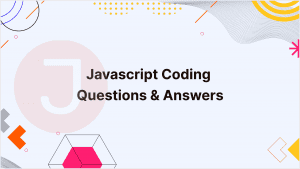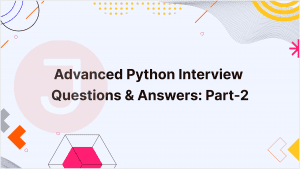Laravel was created by Taylor Otwell, who started developing it in 2011. Laravel uses the MVC (Model-View-Controller) architectural pattern to help developers create clean and expressive syntax for online applications. Here are some Laravel interview questions for experienced applicants that will help you throughout your Laravel technical interview.
Table of Contents
- 1 Interview Questions for 5 years of experience
- 1.1 1. What is Laravel, and why is it popular?
- 1.2 2. Explain the Laravel directory structure.
- 1.3 3. What is Eloquent ORM in Laravel?
- 1.4 4. Explain the concept of middleware in Laravel.
- 1.5 5. Differentiate between GET and POST methods in Laravel.
- 1.6 6. Explain the purpose of Laravel Artisan.
- 1.7 7. What is the purpose of Laravel Homestead?
- 1.8 8. What is the significance of eloquent relationships?
- 1.9 9. Explain the use of Laravel migrations.
- 1.10 10. What are Traits in Laravel?
- 1.11 11. What is the purpose of the with method in Eloquent?
- 1.12 12. Explain the concept of Laravel Middleware Groups.
- 1.13 13. How does Laravel handle user authentication?
- 1.14 14. What is the purpose of the Laravel Blade?
- 1.15 15. Explain the significance of Laravel Eloquent Accessors and Mutators.
- 1.16 16. How does Laravel handle task scheduling?
- 1.17 17. What is dependency injection in Laravel?
- 1.18 18. Explain Laravel Eloquent Soft Deletes.
- 1.19 19. What is the purpose of Laravel Mix?
- 1.20 20. Explain the concept of Laravel Dependency Container.
- 1.21 21. How does Laravel handle caching?
- 1.22 22. What is the purpose of Laravel Eloquent Observers?
- 1.23 23. Explain the use of Laravel policies.
- 1.24 24. How does Laravel handle database transactions?
- 1.25 25. What is Laravel Dusk, and how is it used?
- 1.26 26. Explain Laravel’s method of injection.
- 1.27 27. What is the purpose of Laravel collections?
- 1.28 28. How does Laravel handle error and exception handling?
- 1.29 29. What is the purpose of Laravel Mixins?
- 1.30 30. Explain the concept of Laravel Eloquent Closures.
- 1.31 31. How does Laravel handle file uploads?
- 1.32 32. What is the purpose of Laravel Policies?
- 1.33 33. Explain the use of Laravel Mix.
- 1.34 34. What is the purpose of Laravel Passport?
- 1.35 35. How does Laravel handle database migrations?
- 1.36 36. Explain Laravel Eloquent Scopes.
- 1.37 37. What is the purpose of Laravel task scheduling?
- 1.38 38. How does Laravel handle RESTful resource controllers?
- 1.39 39. Explain the concept of Laravel service providers.
- 1.40 40. What is the purpose of Laravel Eloquent Serialization?
- 1.41 41. How does Laravel handle form validation?
- 1.42 42. Explain the use of Laravel mixers.
- 1.43 43. What is the purpose of Laravel Eloquent Touches?
- 1.44 44. How does Laravel handle multiple database connections?
- 1.45 45. Explain Laravel Authorization Gates.
- 1.46 46. What is the purpose of Laravel HTTP Client?
- 1.47 47. How does Laravel handle pagination?
- 1.48 48. Explain the concept of Laravel Eloquent Encryption.
- 1.49 49. What is the purpose of Laravel Horizon?
- 1.50 50. How does Laravel handle internationalization (i18n) and localization (i10n)?
- 2 FAQ
Interview Questions for 5 years of experience
1. What is Laravel, and why is it popular?
Answer: Laravel is a PHP web application framework distinguished by its clean syntax, developer-friendly features, and solid performance. It uses the Model-View-Controller (MVC) architecture pattern to facilitate development by offering expressive syntax and conventions.
2. Explain the Laravel directory structure.
Answer: Laravel follows a well-organized directory structure. Key directories include:
app: Contains the core code of the application.public: Holds publicly accessible files, like the entry pointindex.php.resources: Contains views, language files, and assets.routes: Defines application routes.database: Manages database-related files, including migrations and seeds.
3. What is Eloquent ORM in Laravel?
Answer: Eloquent is Laravel’s Object-Relational Mapping (ORM) technology, which offers a flexible approach to connecting with databases. It enables developers to interact with databases using an object-oriented syntax, making database operations easier.
4. Explain the concept of middleware in Laravel.
Answer: Middleware functions as a filter for HTTP requests that enter the application. It can execute duties such as authentication, logging, and request modification before proceeding to the application’s core functionality. Laravel includes various built-in middleware, but developers can also design their own.
5. Differentiate between GET and POST methods in Laravel.
Answer: In Laravel, both GET and POST are HTTP methods. GET is used for retrieving data from the server, and parameters are sent in the URL. POST is used for submitting data to be processed, and parameters are sent in the request body, making it suitable for sensitive information.
6. Explain the purpose of Laravel Artisan.
Answer: Artisan is Laravel’s command-line interface, which includes commands for typical activities like as database migration, seeding, and controller creation. It simplifies repetitious operations and increases developer productivity.
7. What is the purpose of Laravel Homestead?
Answer: Laravel Homestead is a pre-configured Vagrant environment for building Laravel apps. It includes PHP, Nginx, MySQL, and other tools that have been configured to operate flawlessly with Laravel. It provides a consistent development environment across several machines.
8. What is the significance of eloquent relationships?
Answer: Eloquent relationships define the relationships between database tables. Laravel supports various types of relationships, including one-to-one, one-to-many, and many-to-many. These relationships make data retrieval and manipulation easier by offering a systematic mechanism to interact with linked models.
9. Explain the use of Laravel migrations.
Answer: Migrations in Laravel are used to version control the database schema. They allow developers to modify database structures using PHP code instead of SQL queries, making sharing and managing database changes easier across development environments.
10. What are Traits in Laravel?
Answer: Traits are a way to group functionality in a fine-grained and consistent way. In Laravel, traits are used to enhance the functionality of classes without using inheritance. They provide code reusability and maintainability.
11. What is the purpose of the with method in Eloquent?
Answer: The with the method in Eloquent is used for eager loading relationships. It helps optimize database queries by fetching related data in a single query instead of loading it lazily, preventing the N+1 query problem.
12. Explain the concept of Laravel Middleware Groups.
Answer: Middleware Groups in Laravel allow developers to group multiple middleware under a single key. This key can then be assigned to routes or controllers, making it convenient to apply a set of middleware to multiple routes at once.
13. How does Laravel handle user authentication?
Answer: Laravel provides a comprehensive authentication system out of the box. Developers can use the make:auth Artisan commands to scaffold basic login and registration views, and the framework includes features like user registration, password reset, and session management.
14. What is the purpose of the Laravel Blade?
Answer: Blade is Laravel’s lightweight templating engine. It provides a convenient syntax for common PHP operations, making it easy to write views. Blade views are compiled into plain PHP code, offering performance benefits.
15. Explain the significance of Laravel Eloquent Accessors and Mutators.
Answer: Eloquent Accessors and mutators allow developers to manipulate attribute values when retrieving from or saving to the database. Accessors modify attribute values before returning them, while mutations modify values before storing them in the database.
16. How does Laravel handle task scheduling?
Answer: Laravel’s task scheduling is achieved through the Artisan command scheduler. Developers can define scheduled tasks in the App\Console\Kernel class, specifying the frequency and the command to be executed. The scheduler runs in the background using the system’s cron.
17. What is dependency injection in Laravel?
Answer: Dependency Injection (DI) is a design pattern in Laravel where dependencies of a class are injected rather than created within the class. Laravel’s IoC (Inversion of Control) container manages the injection of dependencies, promoting flexibility and testability.
18. Explain Laravel Eloquent Soft Deletes.
Answer: Soft Deletes in Laravel allow developers to “softly” delete records by adding a deleted_at column to the database table. Instead of removing the record physically, Laravel marks it as deleted by setting the deleted_at timestamp. Soft deletes can be easily restored if needed.
19. What is the purpose of Laravel Mix?
Answer: Laravel Mix simplifies asset compilation and management by providing a clean API for defining webpack build steps. It is used to compile and minify assets like CSS and JavaScript, making it easier to manage front-end assets in Laravel applications.
20. Explain the concept of Laravel Dependency Container.
Answer: Laravel Dependency Containers are powerful tools for managing class dependencies and performing IoC. It allows developers to bind classes or interfaces to concrete implementations and automatically resolves dependencies when needed.
21. How does Laravel handle caching?
Answer: Laravel provides a unified API for various caching systems, including Redis and Memcached. Developers can use the cache helper to store and retrieve data from the cache. Laravel also supports caching at different levels, such as route caching and configuration caching.
22. What is the purpose of Laravel Eloquent Observers?
Answer: Eloquent observers are used to observe Eloquent model events. Developers can define observer classes to listen for specific events like creating, updating, or deleting records. Observers provide a clean way to separate event-handling logic from the models.
23. Explain the use of Laravel policies.
Answer: Laravel policies define authorization logic for models. They determine if a user is authorized to perform a specific action on a resource. Policies are commonly used with Laravel’s gates and can be associated with Eloquent models.
24. How does Laravel handle database transactions?
Answer: Laravel provides a simple and expressive way to handle database transactions using the transaction method. Developers can wrap database operations in a transaction, ensuring that all operations succeed or fail together. This helps maintain data integrity.
25. What is Laravel Dusk, and how is it used?
Answer: Laravel Dusk is a browser automation and testing tool for Laravel applications. It allows developers to write tests that interact with the application through a browser, providing a convenient way to perform end-to-end testing.
26. Explain Laravel’s method of injection.
Answer: Laravel’s method injection allows developers to type-hint dependencies in a controller method, and the framework automatically resolves and injects the required dependencies. This promotes clean and modular code.
27. What is the purpose of Laravel collections?
Answer: Laravel Collections provides a fluent interface for working with arrays of data. They offer a wide range of methods for filtering, transforming, and manipulating data, making it easier to work with result sets from database queries or other data sources.
28. How does Laravel handle error and exception handling?
Answer: Laravel has a comprehensive error and exception handling mechanism. The App\Exceptions\Handler class is responsible for handling exceptions, and developers can customize error pages, log errors, and respond with appropriate HTTP status codes.
29. What is the purpose of Laravel Mixins?
Answer: Laravel Mixins allow developers to extend Laravel’s core classes with their own methods. This is particularly useful when working with third-party packages or adding custom functionality to existing classes.
30. Explain the concept of Laravel Eloquent Closures.
Answer: Eloquent closures allow developers to define custom query logic using closures. This provides a way to encapsulate complex queries and reuse them across different parts of the application.
31. How does Laravel handle file uploads?
Answer: Laravel simplifies file uploads through the request object. Uploaded files are available through the file method, and Laravel provides convenient methods for tasks like validating file types, moving uploaded files, and handling file storage.
32. What is the purpose of Laravel Policies?
Answer: Laravel policies define authorization logic for models. They determine if a user is authorized to perform a specific action on a resource. Policies are commonly used with Laravel’s gates and can be associated with Eloquent models.
33. Explain the use of Laravel Mix.
Answer: Laravel Mix simplifies asset compilation and management by providing a clean API for defining webpack build steps. It is used to compile and minify assets like CSS and JavaScript, making it easier to manage front-end assets in Laravel applications.
34. What is the purpose of Laravel Passport?
Answer: Laravel Passport is a full OAuth2 server implementation for Laravel applications. It provides a simple way to set up API authentication and token issuance, making it easier to secure APIs and authenticate users.
35. How does Laravel handle database migrations?
Answer: Laravel migrations allow developers to version control the database schema. Developers can create, modify, and delete database tables using Artisan commands, making it easy to share and manage database changes across different environments.
36. Explain Laravel Eloquent Scopes.
Answer: Eloquent Scopes allows developers to define reusable sets of constraints on queries. Scopes are defined as methods on the Eloquent model and can be used to encapsulate common query logic.
37. What is the purpose of Laravel task scheduling?
Answer: Laravel Task Scheduling allows developers to schedule tasks to run at specified intervals. It is accomplished through the Artisan command scheduler, enabling automatic execution of tasks like sending emails, clearing caches, or running custom scripts.
38. How does Laravel handle RESTful resource controllers?
Answer: Laravel supports the creation of RESTful resource controllers, which provide CRUD operations for a resource. Resource controllers streamline the process of building RESTful APIs by defining standard methods like index, create, store, edit, update, destroy, etc.
39. Explain the concept of Laravel service providers.
Answer: Laravel Service Providers are responsible for bootstrapping and registering services with the application. They enable developers to extend Laravel’s functionality by binding classes, registering aliases, and performing other setup tasks.
40. What is the purpose of Laravel Eloquent Serialization?
Answer: Eloquent Serialization allows developers to customize the format in which Eloquent models are converted to JSON. This is useful for controlling the data that is exposed to the client and ensuring a clean API response.
41. How does Laravel handle form validation?
Answer: Laravel simplifies form validation using the validate method, which is typically called in the controller. Developers can define validation rules in the controller or use Form Request classes to encapsulate validation logic.
42. Explain the use of Laravel mixers.
Answer: Laravel Mixins allows developers to extend Laravel’s core classes with their own methods. This is particularly useful when working with third-party packages or adding custom functionality to existing classes.
43. What is the purpose of Laravel Eloquent Touches?
Answer: Eloquent Touches allows developers to update the updated_at timestamp on related models when changes occur. This is useful for scenarios where changes to one model should also affect the timestamp of another related model.
44. How does Laravel handle multiple database connections?
Answer: Laravel supports multiple database connections right out of the box. Developers can define multiple database configurations in the config/database.php file and specify the connection to be used when interacting with the database.
45. Explain Laravel Authorization Gates.
Answer: Laravel Gates provides a simple way to define authorization logic. Developers can use gates to check if a user is authorized to perform a given action, and gates can be associated with specific actions or applied globally.
46. What is the purpose of Laravel HTTP Client?
Answer: Laravel HTTP Client provides a fluent interface for making HTTP requests. It simplifies the process of interacting with external APIs by offering a clean syntax for sending HTTP requests and handling responses.
47. How does Laravel handle pagination?
Answer: Laravel provides a convenient pagination feature for querying large datasets. The paginate the method in Eloquent allows developers to split query results into pages, making it easy to display data in a paginated manner.
48. Explain the concept of Laravel Eloquent Encryption.
Answer: Laravel Eloquent Encryption allows developers to encrypt and decrypt attribute values when storing or retrieving them from the database. This provides an additional layer of security for sensitive data.
49. What is the purpose of Laravel Horizon?
Answer: Laravel Horizon is a dashboard and configuration system for Laravel’s Redis queue. It provides real-time monitoring, job metrics, and configuration options, making it easier to manage and monitor queues in Laravel applications.
50. How does Laravel handle internationalization (i18n) and localization (i10n)?
Answer: Laravel supports internationalization and localization through language files and helper functions. Developers can define language files for different locales, and the application can dynamically load the appropriate language based on the user’s preferences.
These 50 Laravel interview questions and answers cover a wide range of topics, measuring a candidate’s knowledge and competence with Laravel development after 5 years. Whether you’re an interviewer looking to assess a candidate’s skills or a candidate preparing for an interview, these questions should provide important insight into the candidate’s Laravel knowledge.
FAQ
Laravel is well-known for its clean syntax, built-in tools such as Eloquent ORM and Blade templating, and powerful ecosystem, which make web development simple and entertaining.
Eloquent ORM makes database interactions in Laravel easier, allowing developers to interface with databases in an expressive and object-oriented syntax.
Laravel offers a single API for several caching technologies. Developers can cache data, views, and configurations to increase application speed.
Laravel includes built-in security features like as CSRF prevention, input validation, and encryption. In addition, developers can leverage middleware and best practices to secure their apps.
Blade templates in Laravel provide simple syntax, template inheritance, and control structures, which improve view readability and maintainability.




